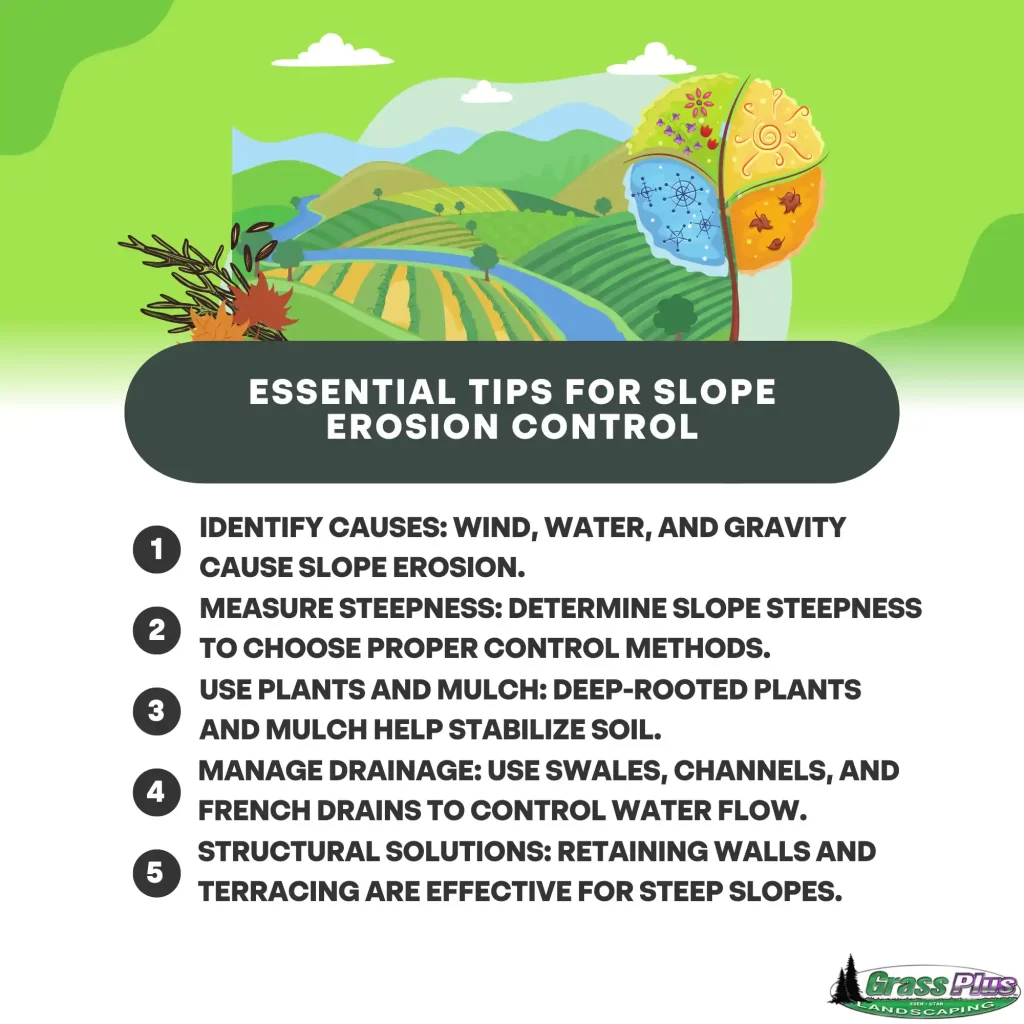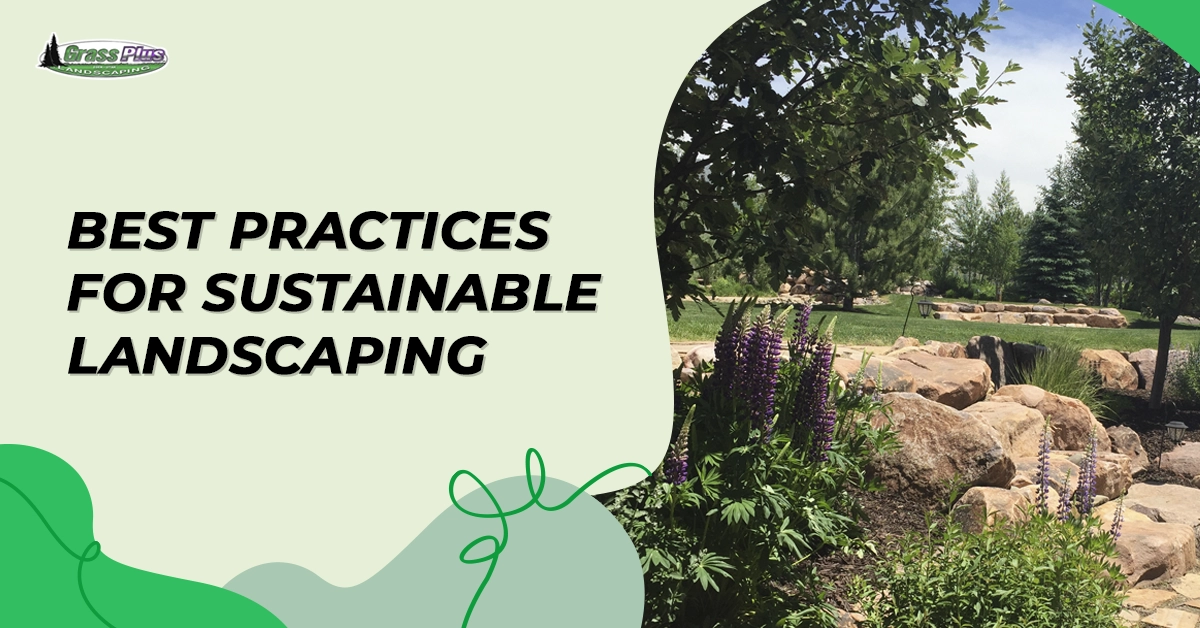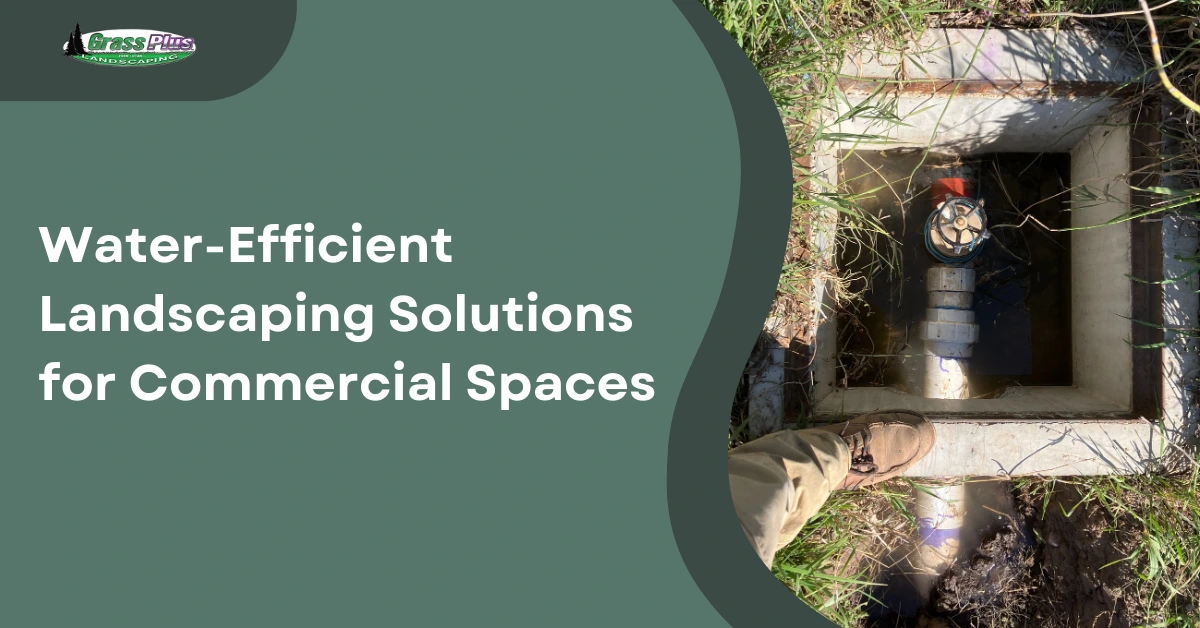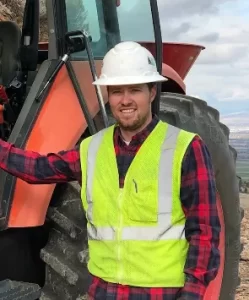Is Your Sloped Yard Turning into a Waterfall? Here’s How to Fight Back!
Imagine waking up to a mini waterfall flowing down your once-pristine yard, just like in a nature documentary. The culprit? Erosion is the relentless thief of healthy soil. Erosion not only carves away the foundation of your beautiful landscape but also pollutes downstream waterways with sediment. Fortunately, you can become a soil superhero and reclaim your yard from this destructive force.

Understanding Erosion: The Enemy You Need to Know
Erosion is when soil gets moved by wind, water, or gravity. On sloped yards, these natural forces become amplified. Raindrops strike the exposed soil with a more significant impact, dislodging particles and sending them on a downhill journey. Sheet erosion, a thin and uniform removal of topsoil, is often the initial culprit. Left unchecked, it can progress to rill erosion, where concentrated water flow carves tiny channels. In the most severe cases, gully erosion creates deep ravines, permanently scarring the landscape.
Several factors accelerate erosion on slopes. Intense rainfall events deliver a concentrated punch. Wind can whip up exposed soil particles, especially in arid regions. Soil composition plays a role, too; sandy soils with loose particles are more vulnerable than those rich in clay. Finally, the lack of vegetation cover is a significant accelerant. Plant roots bind soil particles together, creating a natural defense system.
Assessing Your Slope: Know Your Enemy’s Strength
Before choosing your weapons in the fight against erosion, you need to assess the enemy’s strength – the steepness of your slope. A simple method involves using a clinometer, a tool commonly used in construction. Alternatively, you can improvise with a ruler and a level. Here’s a trick:
- Tie a weight to one end of a string and hold the other end level.
- Measure the distance from the level string to the base of the ruler – that distance divided by the ruler’s length equals the slope as a decimal.
- To get the percentage grade, multiply by 100.
Generally, gentler slopes (less than 10%) are more manageable with natural solutions like plants and mulch. Steeper slopes may require structural interventions like retaining walls.
Natural Warriors: Using Plants to Combat Erosion
Plants are nature’s erosion control superheroes. Their intricate root systems act like a living web, binding soil particles together and creating a physical barrier against raindrop impact. Additionally, plant canopies intercept rainfall, reducing its erosive force. The proper plant selection is critical. Groundcovers like creeping phlox or pachysandra form a dense, low-growing mat that smothers weeds and protects the soil surface. Deep-rooted grasses like switchgrass or vetiver send their anchors deep into the soil, providing additional stability. Shrubs with extensive root networks, such as ninebark or viburnum, are excellent choices for slopes. Trees with strong root systems, like red oak or eastern redbud, offer a powerful defense against erosion, especially on steeper slopes.
Planting on a slope requires extra care. Staggered rows, where plants are positioned higher or lower than their neighbors in the row below, help create a more robust defense. Opt for native plants; they are adapted to your local climate and soil conditions, often requiring less maintenance and water. Choose plants with deep roots for steep slopes to ensure stability.
Mulching Magic: A Natural Armor for Your Slope
Mulch acts like a suit of armor for your slope. This layer slows water, letting it soak into the ground rather than washing away the topsoil. Mulch keeps the soil moist, reducing drought effects and helping plants grow healthy. Additionally, a well-maintained mulch layer suppresses weed growth, eliminating competition for water and nutrients with your erosion-fighting plants.
The choice of mulch material depends on your specific needs and aesthetics. Wood chips, shredded bark, and pine needles keep moisture well and look natural. Gravel can also be adequate, especially on steeper slopes, but it provides less organic matter and may only be aesthetically pleasing in some landscapes. When choosing, balance its usefulness and looks.
It is crucial to apply mulch effectively on slopes. Aim for a 2—to 3-inch layer to provide adequate protection. On steeper slopes, you should use mulch anchoring techniques like landscape fabric or edging stones to prevent washout during heavy rains.
Water on a Leash: Techniques to Manage Drainage
Proper drainage is the key to winning the battle against erosion. Water pooling at the top of your slope creates a concentrated flow path, accelerating erosion. Diverting water flow is the first line of defense. Swales, shallow, elongated depressions in the soil, channel water away from the slope and towards a stable drainage area.
You can line swales with gravel or vegetation to improve their effectiveness. Channels, similar to swales but often lined with concrete or plastic, are another option for diverting water flow on steeper slopes. French drains, essentially buried perforated pipes surrounded by gravel, collect and channel water underground, directing it away from the slope and towards a suitable drainage outlet.
Your gutters and downspouts also play a crucial role. Ensure your gutters are free of debris and adequately angled to efficiently collect and direct rainwater away from your house and the top of the slope. Consider extending downspouts to discharge water further away from the hill, potentially into a rain barrel or a designated drainage area.
Hold That Hill: Structural Solutions for Steeper Slopes
When natural solutions reach their limit, structural interventions become necessary. Steeper slopes, often exceeding 20-degree grades, require retaining walls to prevent erosion. These walls act as physical barriers, holding back soil and preventing it from washing away.
Terraced gardens are a series of leveled platforms created by retaining walls, breaking up the slope, and creating mini-plateaus. This not only enhances aesthetics but also reduces the overall slope angle, making it more manageable with natural erosion control methods like plants and mulch.
Different retaining walls have their pros and cons. Gabion walls, constructed from cages filled with stones, offer a natural look and excellent drainage. Concrete or interlocking block walls are popular due to their durability and ease of construction. When selecting a retaining wall, consider factors like cost, aesthetics, the height needed to retain the soil, and the overall stability of the slope. Ask a landscaper for the best option for you.
The Erosion Control Toolbox: Additional Techniques
Beyond the core strategies, there are additional tools in your erosion control arsenal. Erosion control blankets, biodegradable mats made of straw or coir, can be used on freshly planted slopes. These temporary blankets hold soil in place while vegetation establishes its root system.
Check dams and small barriers constructed from stone or wood across channels can be used to slow down the flow of water and prevent gully erosion. Live stakes, essentially fast-rooting woody plant cuttings inserted directly into the slope, are a quick and effective way to establish vegetation and stabilize bare soil.
Beyond Your Yard: Erosion Control for the Greater Good
Erosion in your yard doesn’t happen in isolation. Sediment washed away from your property can clog waterways downstream, harming aquatic ecosystems. It can also increase flooding risks for your neighbors.
There are simple ways to minimize erosion from your property, even if you don’t have a sloped yard. Redirect runoff from driveways and patios by creating swales or channels that direct water toward a designated drainage area. Consider planting rain gardens, which are shallow, bowl-shaped depressions filled with native plants that absorb and filter rainwater runoff before it can cause erosion.
Erosion control is often most effective when tackled as a community effort. Collaborate with your neighbors to implement joint solutions, such as creating buffer strips along streams or collectively maintaining drainage ditches. Feel free to contact your local authorities to inquire about any available programs or resources for erosion control in your area.
Maintaining Your Victory: Long-Term Erosion Control Strategies
The fight against erosion is a marathon, not a sprint. Regularly inspect your slope for signs of erosion, such as exposed soil, rills (tiny channels), or small landslides. Please address any issues promptly to prevent them from escalating.
Maintaining your plant cover is crucial. Replant bare spots as soon as possible to ensure continuous soil protection. Regularly control weeds, as they compete with your erosion-fighting plants for water and nutrients. Overgrown vegetation can also be problematic, so trim shrubs and trees strategically to avoid blocking drainage paths.
Remember your drainage system. Clean clogged gutters and downspouts regularly. Inspect swales and channels for signs of erosion or blockage and make repairs as needed. Retaining walls should also be checked periodically for cracks or signs of movement.
Going Green for Less: Budget-Friendly Erosion Control Solutions
Even with a limited budget, you can still wage a successful war against erosion. Use recycled wood scraps or cardboard (covered with plastic sheeting) to create mulch or edging for your swales.
Many native wildflowers and creeping perennials are low-cost options for erosion control. They often require minimal maintenance and can even attract beneficial pollinators to your yard. Drought-tolerant grasses are another budget-friendly choice, especially in regions with limited rainfall.
For drainage solutions, consider DIY projects. Simple swales can be created with shovels and essential tools. Channel drainage using recycled lumber or stones. Remember, consulting a professional for guidance before undertaking any major DIY projects is always recommended.
The Erosion Fighter’s Toolkit: Resources for Homeowners
Empowering yourself with knowledge is vital to long-term success in the fight against erosion. Here’s a toolkit packed with valuable resources:
- Government Websites and Local Extension Services: Many government agencies offer comprehensive information on erosion control practices. Websites often provide downloadable guides, fact sheets, and even interactive tools to help you assess your slope and choose appropriate solutions. Local extension services can be a treasure trove of practical advice tailored to your specific region’s climate and soil conditions.
- Online Resources and Forums: The internet is brimming with online resources dedicated to erosion control. Educational websites, gardening blogs, and forums can provide valuable insights, tips, and inspiration. Feel free to connect with other homeowners facing similar challenges through online forums. Learning from each other’s wins and losses through sharing experiences is effective.
- Professional Landscapers: For complex erosion problems or steeper slopes, consulting a professional landscaper is highly recommended. A qualified landscaper can assess your specific situation, recommend the most effective solutions, and even handle the installation of complex erosion control measures like retaining walls or French drains.
Conclusion: A Sustainable and Beautiful Sloped Landscape
Erosion can be conquered with the proper knowledge and strategies. By employing a combination of natural solutions like plants and mulch, strategic water management techniques, and structural interventions where necessary, you can reclaim your sloped yard and create a beautiful, healthy, and sustainable landscape. A healthy slope protects your property and benefits the environment downstream. So, take heart, grab your metaphorical shovel, and embark on your journey to becoming a soil superhero!
Ready to Stop the Slide and Save Your Soil? Contact Grass Plus Inc. Today!
Feeling overwhelmed by the battle against erosion in your sloped yard? Don’t despair! Taking control is easier than you think. Use this guide to turn your slope into a thriving landscape by following the outlined strategies. But if you’d like some expert help to ensure success, look no further than Grass Plus Inc. We’re a trusted provider of Idaho erosion control services near you. Search “Idaho erosion control services near me” to find us online, or give us a call today. Our team of experienced professionals is here to assess your slope, recommend the most effective solutions, and help you achieve a beautiful and erosion-free yard.





